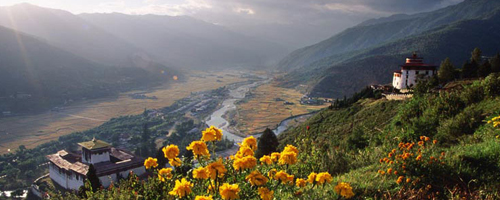India LTC Tour
- Goa LTC Tour
- Kerala LTC Tour
- Himachal LTC Tour
- Rajasthan LTC Tour
- Kashmir LTC Tour
- Darjeeling LTC Tour
- Andaman Nicobar LTC Tour
- Mahabaleswar LTC Tour
- Coorg LTC Tour
- Kodaikanal LTC Tour
- Mount Abu LTC Tour
- Nainital Tour Packages
- Ooty LTC Tour
- Leh - Ladakh LTC Tour
- Amarnath Yatra
- Mata Vaishno Devi Yatra
International LTC Tour
| BHUTAN LTC TOURS |
INTERNATIONAL LTC TOURS |
Holidays in Bhutan
1 Night Phuentsholling | 2 Nights Thimpu | 01 Night Punakha | 01 Night Wangduephodrang | 2 Nights Paro | 1 Night Phuentsholling
- Tour Itinerary
- Packages Overview
- Hotel Details
- Destinations
- Enquire now
Suggested Itinerary
Day 01: Arrival and Transfer to Phuentsholling
Our representative will receive the Guest at New Jalpaiguri Railway Station (NJP) / Bagdogra Airport (IXB) / Tenzing Norgay Bus Stand (Junction) – He will be assisting for the transfer via Jaigaon to Phuentsholling - The border of India & Bhutan, Indian side is Jaigaon and the Bhutan side is called Phuentsholling - Nearly 170 kilometers 3 ½ - 4 hours drive – The drive is through Dooars - Land of breathtaking beauty, sloping tea gardens with spectacular views of the - Check into hotel – Evening free to roam around Mall or local Shopping center - Over Night stay at Phuentsholling
Day 02: Transfer to Thimpu after Permit formalities
After preparing permit etc - Transfer from Jaigaon / Phuentsholling to Thimpu - 180 kilometers – Nearly 6 ½ - 7 ½ hours – The drive will take guest along the Paro Chu (water or river) down stream to the confluence with the Wang Chu next the road bends upstream and travel along the Wang Chu to Thimpu - One can experience breath taking view of Mount Everest, Kanchenjunga and other famous Himalayan peaks including the sacred Jumolhari and Mount Jichu Drake - Check into hotel – Evening free to roam around Mall or local Shopping center - Over Night stay at Thimpu
Day 03: Thimpu sight seeing
Early morning breakfast – Drive and visit the Memorial Chorten (Stupa) built in memory of the third King of Bhutan who ruled the Kingdom from 1952-1972 - Next the National Library where ancient manuscripts are preserved, Wood Craft and Painting School - The handicrafts Emporium where Bhutanese textiles and other arts and crafts are displayed and can be purchased - Simtokha Dzong, one of the oldest fortresses in Bhutan built by Shabdrung Ngawang Namgyal in 1629 A.D - Browse through example of Bhutan's fine traditional arts. Here you can buy hand-woven textiles, thangkha paintings, masks, ceramics, slate and wood carvings, jewelry, interesting items made from local materials – Night stay at Thimpu
Day 04: Thimphu – Wangduephodrang - Punakha Transfer via Dochu La Pass
Early morning breakfast - After breakfast, drive to Wangduephodrang, with a stop en route for tea break at Dochu La (3,100 meters), where on a clear day you can get a spectacular view of the Himalayas - After lunch, will continue drive to Punakha, the former capital of Bhutan, and visit Punakha Dzong, which is noteworthy both for being one of the most beautiful dzongs in Bhutan and also for having been built by the first Shabdrung in 1637 – Check into Hotel – Evening free to stroll around the region - Night stay at Punakha
Day 05: Punakha - Gangtey – Wangduephodrang Transfer
Early morning breakfast – After breakfast visit Gangtey - Passing through dense forests of oak trees and rhododendrons and arrive at Gangtey Village, where you will visit Gangtey Gompa, the only Nyingmapa Monastery in Western Bhutan - From Gangtey, you can enjoy the picturesque Black Mountain range as well as Phobjika Valley, the winter habitat of the black necked cranes - In the evening stroll through the town of Wangduephodrang and visit the shops – Night stay at hotel / resort in Wangduephodrang
Day 06: Transfer Wangduephodrang to Paro – Early morning breakfast
Morning, set out for Paro with a stop in Thimphu for lunch and a visit to the Folk Heritage Museum - In the afternoon, will continue drive to Paro and visit a traditional farmhouse – Check into hotel in Paro – Evening free to stroll around the area – night stay at hotel in Paro
Day 07: Paro Sight seeing
Morning two hours hike to reach Taktshang monastery - Tiger's Nest - Later visit Drugyel Dzong (fortress) - The Dzong was built in 1649 by Shabdrung Nawang Namgyel to commemorate the victory of Bhutan over Tibetan Invaders in 1644 - Destroyed by fire in 1951 - Spectacular view of sacred Mountain Jumolhari is worth it - On the way back view Taktsang Monastery perched on the side of a cliff at 900 meters - Visit Kychu Lhakhang, one of the oldest temples - National Museum popularly known to the local Bhutanese as Ta Dzong or Watch Tower - Built as Watch Tower (Ta Dzong) of Paro Dzong and the Valley was renovated and converted into National Museum in 1968 - Evening stroll around Paro town Night stay at Paro
Day 08: Departure – Transfer from Paro to Phuentsholling – Early morning breakfast
Transfer from Paro to Jaigaon / Phuentsholling - A drive of nearly 180 kilometers, a drive of approximately 6 ½ - 7 hours - After breakfast transfer to Phuentsholing – On the way take a short stop at Chuzom, the confluence of Paro and Thimphu rivers with three different style of stupas adorn this confluence - Drive further through Chapcha and later take glimpse of famous Chukha Dam and the magnificent Vince waterfall before Gedu town - Arrive Phuenthsoling by evening and check into the hotel – Evening free to stroll around the area - Night stay at hotel in Phuentsholing.
Day 09: Departure and Transfer to New Jalpaiguri Railway Station (NJP) / Bagdogra Airport (IXB) / Tenzing Norgay Bus Stand (Junction)
Early morning breakfast - Drive to Siliguri - New Jalpaiguri Railway Station (NJP) / Bagdogra Airport (IXB) / Tenzing Norgay Bus Stand (Junction) - Morning breakfast - After breakfast transfer to Siliguri / New Jalpaiguri Railway Station (NJP) / Bagdogra Airport (IXB) / Tenzing Norgay Bus Stand (Junction) - Nearly 180 kilometers 3 ½ - 4 ½ hours drive – Forwarding Journey.
Package Inclusions:
- Daily breakfast
- Accommodation on twin sharing basis
- All transfers & sightseeing by dedicated vehicle
- Permit fees & hotel taxes (as per itinerary).
Package Exclusions:
- Air Fare
- Entry fess, Camera fees, Portarage, Tips & Gratuity and Mineral/soft/hard drinks
- Extra usage of vehicle
- Guide
- Applicable Peak Season, Christmas, New year surcharges
- Items of Personal Nature
- Travel Insurance
- Service tax extra @ 3.09% is applicable
- Anything not mentioned above
Hotel Details
| Destinations | Hotels |
| Phuncholing | Hotel Lakhi / Hotel Namagey / Similar |
| Thimpu | Hotel Raven Inn / River View / Dragon Roots/ Phuntsho Pelri / Jumolhari |
| Wangdi | Dragon Nest Resort / Similar |
| Paro | Tenzinling Resort / Tashi Phuntshok / Dechen Cottages / Similar |
| Punakha | Dumchen Resort / Hotel Zangtho Pelri |
Thimpu
Since 1960, the capital of Bhutan is Thimphu. Thimphu is situated at a height of over 7600 feet on a hillside in a fertile valley on the banks of the Thimphu Chhu River. Thimphu is perhaps the smallest capital in the world. The town of Thimphu is nothing like what a capital city is imagined to be. Thimphu Bhutan One interesting fact about this city is that it is the only world capital without any traffic lights. Thimphu is a gallery of traditional Bhutanese art, architecture, culture, and tradition and above all still so ethnic and pure. It is a fitting and lively place. The wooden houses stand side by side with concrete buildings, all painted and constructed in traditional Bhutanese styles. For most part of its history, Bhutan has tried consciously to save its culture from the blunt influences of the western world. It is not that modernity has not reached this region, but they are being introduced in a phased and balanced manner that is unheard of at any place in the world. All these make Thimphu and other parts of the country a unique destination.
Phuentsholling
Phuentsholing is the second largest town in Bhutan and is located on the Indian border, next to the town of Jaigaon.
Punakha
Punakha is the winter seat of the Central Monk Body. Until 1955, Punakha served as the capital of Bhutan. The Punakha valley is drained by the Phochu and Mochu rivers. This valley produces rich crops of rice and fruits, including mangoes, bananas and oranges. Punakha has a temperate climate. The road from Thimphu to Punakha is crossed through a 10,218 feet high Dochu La Pass. This pass offers enchanting views Punakha Bhutan of alpine snows and red, pink, white, yellow and purple rhododendron flowers. The Punakha Dzong, Jampe Lhakhang and Kurje monastery are the main tourist attractions in Punakha. In 1637, Shabdrung Ngawang Namgyel built the Punakha Dzong (fortress) at the junction of the Phochu and Mochu rivers to serve as the religious and administrative centre of Bhutan. Punakha Dzong houses many sacred temples, including the Machhin Lhakhang, where the embalmed body of Shabdrung Ngawang Namgyel lies in state in keeping with tradition. Today, various rituals, including the serving of meals, is carried out as it was during the Shabdrung's life. This dzong was damaged four times by fire in the late 18th and early 19th centuries and by earthquakes in 1897. The Punakha Dzong also suffered devastation by floods. The Dzong was completely restored under the direction of the present King. The sacred Jampe Lhakhang and Kurje monasteries are believed to have been built in the eighth century by Sindhu Raja whom Padmasambhava cured of his ailment. The body marks of Guru Padmasambhava are still imprinted on a solid rock.
Paro
Paro is the gateway to the country of Bhutan. Situated in the Paro Valley of Eastern Himalaya, the town is full of legends, heroism, and natural splendour. If there would be a place where nature and Paro Bhutan man conjured to create their clearest and cleanest image, it must be the Paro valley in Bhutan. The town is located at an altitude of 2,250 m above the sea level with river flowing gently on its side and making it the most beautiful valley in the country. Though, the capital of Bhutan is Thimphu, but for a longer time of the history Paro had the control of this part of the country. The town of Paro in western Bhutan attracts tourists due to its scenic locales, beautiful landscapes, wooded villages and historic buildings. The Paro valley is unique in beauty and in history. The only airport of Bhutan is located in Paro. To the north, Mount Chamolhari (Mountain of the Goddess), reigns in white glory and the waters from its "five sisters" peaks passes through deep gorges, finally meeting in the end to form the Paro Chu river that nourishes the rice fields and apple and peach orchards.
Please fill this form to send us your travel requirement and our team will contact you as soon as possible.



